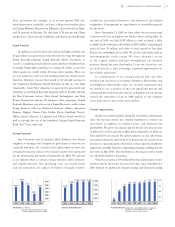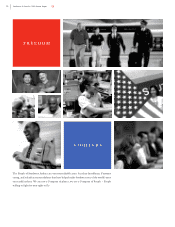Southwest Airlines 2003 Annual Report Download - page 20
Download and view the complete annual report
Please find page 20 of the 2003 Southwest Airlines annual report below. You can navigate through the pages in the report by either clicking on the pages listed below, or by using the keyword search tool below to find specific information within the annual report.
PART I
Item 1. Business
Description of Business
Southwest Airlines Co. (“Southwest”) is a major domestic airline that provides predominantly shorthaul,
high-frequency, point-to-point, low-fare service. Southwest was incorporated in Texas in 1967 and
commenced Customer Service on June 18, 1971 with three Boeing 737 aircraft serving three Texas cities -
Dallas, Houston, and San Antonio.
At year-end 2003, Southwest operated 388 Boeing 737 aircraft and provided service to 59 airports in
58 cities in 30 states throughout the United States. Southwest Airlines topped the monthly domestic
passenger traffic rankings for the first time in May 2003. Based on monthly data from May through August
2003 (the latest available data), Southwest Airlines is the largest carrier in the United States based on
originating domestic passengers boarded and scheduled domestic departures. The Company recently
announced that it intends to begin service to Philadelphia in May 2004.
One of Southwest’s competitive strengths is its low operating costs. Southwest has the lowest costs,
adjusted for stage length, on a per mile basis, of all of the major airlines. Among the factors that contribute
to its low cost structure are a single aircraft type, an efficient, high-utilization, point-to-point route structure,
and hardworking, innovative, and highly productive Employees.
The business of the Company is somewhat seasonal. Quarterly operating income and, to a lesser
extent, revenues tend to be lower in the first quarter (January 1 - March 31) and fourth quarter (October 1 -
December 31) of most years.
Southwest’s filings with the Securities and Exchange Commission (“SEC”), including its annual
report on Form 10-K, quarterly reports on Form 10-Q, current reports on Form 8-K and amendments to those
reports are accessible free of charge at www.southwest.com.
Fuel
The cost of fuel is an item having significant impact on the Company's operating results. The
Company's average cost of jet fuel, net of hedging gains, over the past five years was as follows:
Year
Cost
(Millions)
Average Cost
per Gallon
Percent of
Operating Expenses
1999 $492 $.53 12.5%
2000 $804 $.79 17.4%
2001 $771 $.71 15.6%
2002 $762 $.68 14.9%
2003 $830 $.72 15.2%
From October 1, 2003 through December 31, 2003, the average cost per gallon was $.74. See
“Management’s Discussion and Analysis of Financial Condition and Results of Operations” for a discussion
of Southwest’s fuel hedging activities.
Regulation
Economic. The Dallas Love Field section of the International Air Transportation Competition Act of
1979, as amended in 1997 (commonly known as the “Wright Amendment”), as it affects Southwest's
scheduled service, provides that no common carrier may provide scheduled passenger air transportation for
compensation between Love Field and one or more points outside Texas, except that an air carrier may
transport individuals by air on a flight between Love Field and one or more points within the states of
























